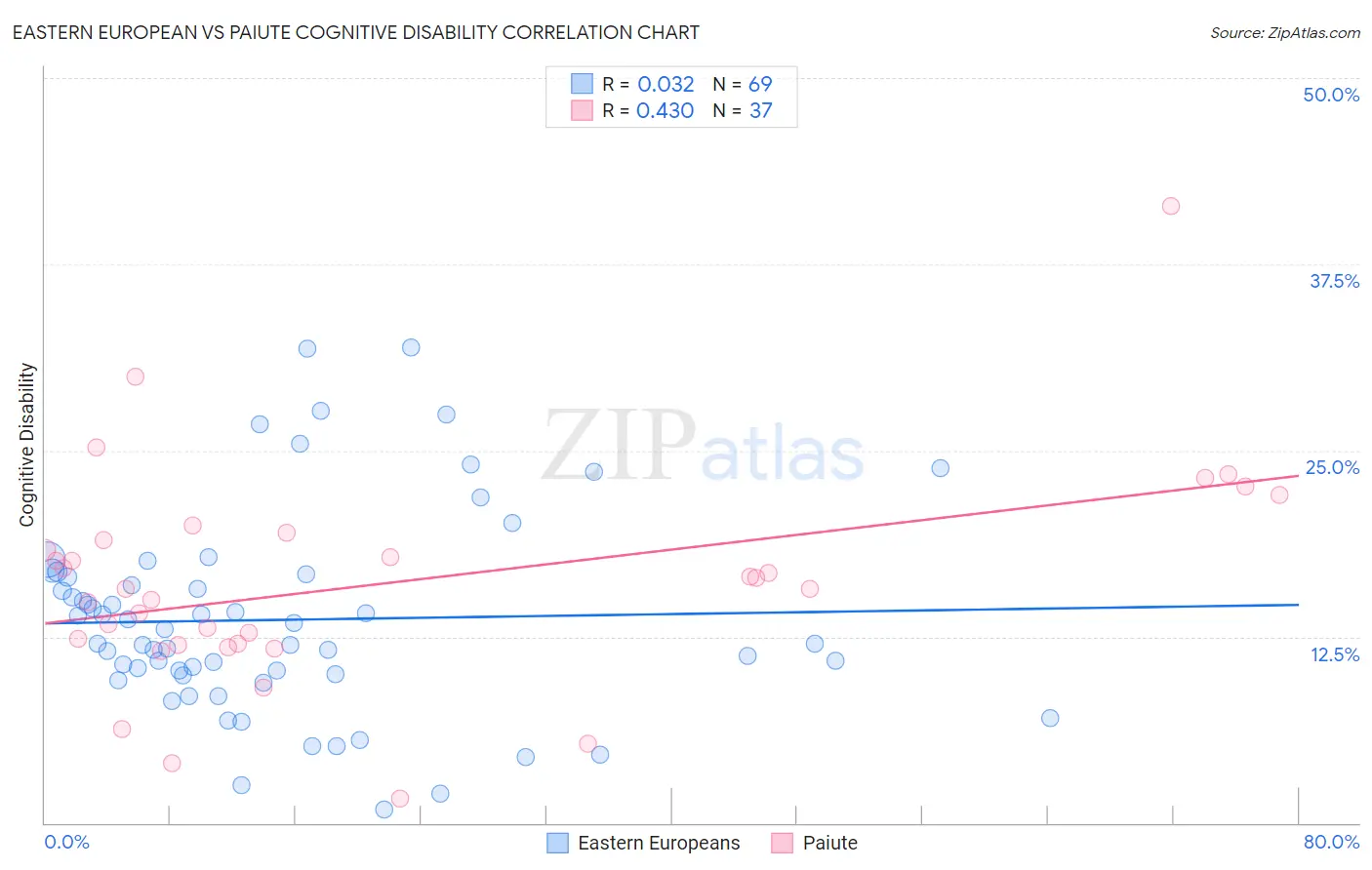Eastern European vs Paiute Cognitive Disability
COMPARE
Eastern European
Paiute
Cognitive Disability
Cognitive Disability Comparison
Eastern Europeans
Paiute
16.3%
COGNITIVE DISABILITY
100.0/ 100
METRIC RATING
16th/ 347
METRIC RANK
17.8%
COGNITIVE DISABILITY
1.1/ 100
METRIC RATING
242nd/ 347
METRIC RANK
Eastern European vs Paiute Cognitive Disability Correlation Chart
The statistical analysis conducted on geographies consisting of 461,204,050 people shows no correlation between the proportion of Eastern Europeans and percentage of population with cognitive disability in the United States with a correlation coefficient (R) of 0.032 and weighted average of 16.3%. Similarly, the statistical analysis conducted on geographies consisting of 58,394,773 people shows a moderate positive correlation between the proportion of Paiute and percentage of population with cognitive disability in the United States with a correlation coefficient (R) of 0.430 and weighted average of 17.8%, a difference of 9.3%.

Cognitive Disability Correlation Summary
| Measurement | Eastern European | Paiute |
| Minimum | 0.87% | 1.6% |
| Maximum | 31.9% | 41.4% |
| Range | 31.0% | 39.8% |
| Mean | 13.6% | 16.1% |
| Median | 12.1% | 15.8% |
| Interquartile 25% (IQ1) | 9.9% | 12.0% |
| Interquartile 75% (IQ3) | 16.6% | 19.2% |
| Interquartile Range (IQR) | 6.7% | 7.2% |
| Standard Deviation (Sample) | 6.7% | 7.3% |
| Standard Deviation (Population) | 6.7% | 7.2% |
Similar Demographics by Cognitive Disability
Demographics Similar to Eastern Europeans by Cognitive Disability
In terms of cognitive disability, the demographic groups most similar to Eastern Europeans are Immigrants from North Macedonia (16.3%, a difference of 0.020%), Immigrants from Northern Europe (16.3%, a difference of 0.080%), Immigrants from Bolivia (16.3%, a difference of 0.090%), Bulgarian (16.3%, a difference of 0.10%), and Immigrants from Cuba (16.3%, a difference of 0.14%).
| Demographics | Rating | Rank | Cognitive Disability |
| Assyrians/Chaldeans/Syriacs | 100.0 /100 | #9 | Exceptional 16.2% |
| Immigrants | Scotland | 100.0 /100 | #10 | Exceptional 16.2% |
| Immigrants | Czechoslovakia | 100.0 /100 | #11 | Exceptional 16.2% |
| Maltese | 100.0 /100 | #12 | Exceptional 16.2% |
| Lithuanians | 100.0 /100 | #13 | Exceptional 16.3% |
| Immigrants | Austria | 100.0 /100 | #14 | Exceptional 16.3% |
| Immigrants | Greece | 100.0 /100 | #15 | Exceptional 16.3% |
| Eastern Europeans | 100.0 /100 | #16 | Exceptional 16.3% |
| Immigrants | North Macedonia | 100.0 /100 | #17 | Exceptional 16.3% |
| Immigrants | Northern Europe | 100.0 /100 | #18 | Exceptional 16.3% |
| Immigrants | Bolivia | 100.0 /100 | #19 | Exceptional 16.3% |
| Bulgarians | 100.0 /100 | #20 | Exceptional 16.3% |
| Immigrants | Cuba | 100.0 /100 | #21 | Exceptional 16.3% |
| Immigrants | South Central Asia | 99.9 /100 | #22 | Exceptional 16.4% |
| Croatians | 99.9 /100 | #23 | Exceptional 16.4% |
Demographics Similar to Paiute by Cognitive Disability
In terms of cognitive disability, the demographic groups most similar to Paiute are Mexican (17.8%, a difference of 0.020%), Immigrants from Bangladesh (17.8%, a difference of 0.070%), Jamaican (17.9%, a difference of 0.11%), Iraqi (17.8%, a difference of 0.16%), and Cajun (17.8%, a difference of 0.19%).
| Demographics | Rating | Rank | Cognitive Disability |
| Spanish American Indians | 2.0 /100 | #235 | Tragic 17.8% |
| Immigrants | Iraq | 1.8 /100 | #236 | Tragic 17.8% |
| Immigrants | Mexico | 1.8 /100 | #237 | Tragic 17.8% |
| Cheyenne | 1.7 /100 | #238 | Tragic 17.8% |
| Cajuns | 1.4 /100 | #239 | Tragic 17.8% |
| Iraqis | 1.4 /100 | #240 | Tragic 17.8% |
| Mexicans | 1.1 /100 | #241 | Tragic 17.8% |
| Paiute | 1.1 /100 | #242 | Tragic 17.8% |
| Immigrants | Bangladesh | 1.0 /100 | #243 | Tragic 17.8% |
| Jamaicans | 0.9 /100 | #244 | Tragic 17.9% |
| Trinidadians and Tobagonians | 0.8 /100 | #245 | Tragic 17.9% |
| Immigrants | Thailand | 0.8 /100 | #246 | Tragic 17.9% |
| Samoans | 0.7 /100 | #247 | Tragic 17.9% |
| French American Indians | 0.7 /100 | #248 | Tragic 17.9% |
| Cree | 0.7 /100 | #249 | Tragic 17.9% |